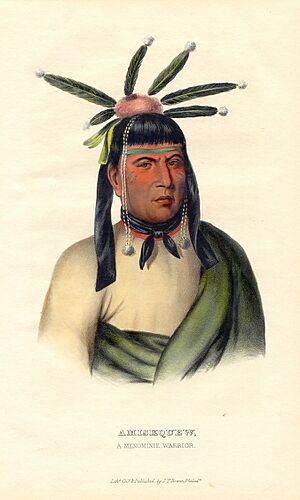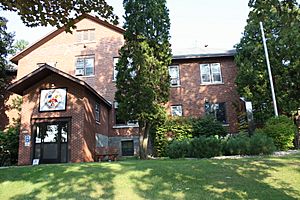Menominee facts for kids
Quick facts for kids omǣqnomenēwak |
|
|---|---|

Chief Oshkosh, c.1858
|
|
| Total population | |
| 8,700 | |
| Regions with significant populations | |
| Wisconsin, Menominee Indian Reservation |
|
| Languages | |
| English, Menominee | |
| Religion | |
| Catholic, Big Drum, Native American Church | |
| Related ethnic groups | |
| Potawatomi, Ojibwe, Kickapoo |
The Menominee (pronounced "muh-NAH-muh-nee") are a group of Native Americans. Their name in their own language is omǣqnomenēwak, which means "Menominee People." Another name they use for themselves is Mamaceqtaw, meaning "the people." The name "Menominee" comes from the Ojibwe language and means "Wild Rice People." This is because wild rice was a very important food for them.
The Menominee are a federally recognized nation (meaning they have their own government and special relationship with the U.S. government). Their main land is the Menominee Indian Reservation in Wisconsin. Long ago, their traditional lands covered about 10 million acres (40,000 square kilometers) in what is now Wisconsin and the Upper Peninsula of Michigan. Today, there are about 8,700 Menominee members.
In the 1960s, the U.S. government tried to end its special relationship with many Native American tribes. This policy was called "termination." The Menominee tribe was affected by this. During this time, they went to the U.S. Supreme Court to protect their rights to hunt and fish. In a famous case called Menominee Tribe v. United States (1968), the Supreme Court decided that the Menominee had not lost their traditional hunting and fishing rights, even though their federal recognition was ended.
The Menominee tribe worked hard to get their federal recognition back. In 1973, the U.S. Congress passed a law to restore their status. In 1975, their reservation was re-established. They now have their own written constitution and an elected government. In 1979, they took over managing their own tribal government and services.
Contents
Who Are the Menominee People?
The Menominee are part of the Algonquian language family. This family includes many tribes found around the Great Lakes and along the Atlantic coast. The Menominee have lived in what is now upper Michigan and Wisconsin for over 1,000 years. Some believe they are related to the ancient Old Copper Culture people. These people lived in the area for as long as 10,000 years.
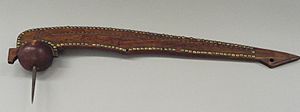
Menominee oral history says they have always been in this land. They call themselves Kiash Matchitiwuk, meaning "Ancient Ones." Their reservation is about 60 miles (97 km) west of where their creation story says they began. This place is where the Menominee River flows into Green Bay of Lake Michigan. The city of Marinette, Wisconsin is there now.
Historically, the Menominee were known as a peaceful and friendly nation. They had a good reputation for getting along with other tribes. When the Oneota culture appeared in southern Wisconsin around 800 to 900 AD, the Menominee shared the forests and waters with them.
Menominee Culture and Traditions
The Menominee are a Northeastern Woodlands tribe. European explorers first met them in Wisconsin in the mid-1600s. The French explorers and traders called them "folles avoines" (wild oats). This name referred to the wild rice they grew and gathered as a main food.
The Menominee traditionally ate many different plants and animals. Wild rice and sturgeon fish were two of the most important. Wild rice is special to the tribe as their main grain. The sturgeon is important in their myths and is often called the "father" of the Menominee. They still hold annual feasts where these foods are served.
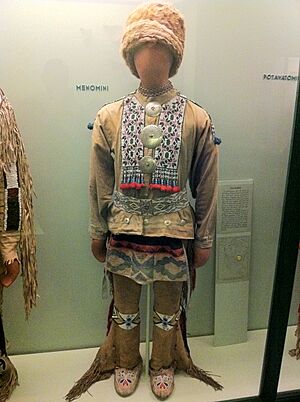
Menominee customs are similar to those of the Chippewa (Ojibwa) people. Their language is closer to the Fox and Kickapoo tribes. All these tribes spoke Algonquian languages.
The Menominee have five main clans: the Bear, Eagle, Wolf, Crane, and Moose. Each clan has special duties within the tribe. The Menominee have a patrilineal kinship system. This means children get their social status from their fathers and are born into their father's clan. People from the same clan are considered relatives. So, they must choose marriage partners from a different clan.
Coming of Age and Beliefs
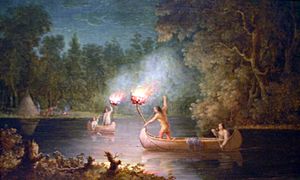
Traditional Menominee spiritual culture includes rites of passage for young people when they reach puberty. These ceremonies involve fasting for several days. Young people live alone in a small, isolated wigwam. During this time, they meet with Elders to understand their dreams. They also learn about the adult responsibilities they will take on after their rite of passage.
Traditional Plant Uses
The Menominee traditionally used many local plants for food and medicine. For example, Allium tricoccum (wild garlic) was part of their diet. They would boil and slice Sagittaria cuneata potatoes, then dry them for winter.
Uvularia grandiflora (bellwort) was used to treat pain and swelling. Pseudognaphalium obtusifolium (rabbit tobacco) was also used as medicine. Taenidia integerrima (from the parsley family) was used for lung problems. Its root was chewed or steeped for bronchial issues. It was also added to other remedies for its good smell.
They used Abies balsamea (balsam fir) in many ways. The inner bark was a seasoning for medicines. An infusion of the inner bark was taken for chest pain. The liquid balsam from the trunk was used for colds and lung problems. They also used the inner bark as a poultice for illnesses. Gum from plant blisters was applied to sores.
Menominee History
[[CSS image crop |Image = Tourist's Pocket Map Of Michigan (Samuel Augustus Mitchell, 1835).jpg |bSize = 1500 |cWidth = 375 |cHeight = 550 |oTop = 400 |oLeft = 120 |Location = right |Description = Wisconsin Territory in 1835, showing Brown County, Wisconsin where Menominee lived. ]]
The Menominee tribe originally lived on a large area of about 10 million acres (40,000 square kilometers). This land stretched from Wisconsin into the Upper Peninsula of Michigan. The Menominee are descendants of the Late Woodland Indians. These groups lived on lands once used by the Hopewell Indians, who were some of the earliest people in the Lake Michigan area.
French fur traders and explorers met the Menominee and other tribes in the 1600s. It is believed that the French explorer Jean Nicolet was the first non-Native American to reach Lake Michigan in 1634 or 1638.
First Meetings with Europeans
In 1634, the Menominee and Ho-Chunk people saw the French explorer Jean Nicolet arrive. This happened near what is now Green Bay, Wisconsin. Nicolet was looking for a way to China. He hoped to impress the people he found. When his canoe neared the shore, Nicolet put on a silk Chinese robe and fired two pistols.
Pierre François Xavier de Charlevoix, a French explorer, wrote about meeting the Menominee in 1721. He called them Malhomines (Wild Oat Indians). He noted that they were "the finest and handsomest men in all Canada."
The 1800s and Land Changes
At first, the Menominee were neutral during the War of 1812. Later, they joined the British and Canadians. They helped them defeat American forces at the Battle of Mackinac Island. In the years that followed, more European-American settlers moved into the Menominee's lands.
From 1821 to 1848, the Menominee gradually sold much of their land in Michigan and Wisconsin to the U.S. government. The government wanted to move them further west. However, Chief Oshkosh visited the proposed new land and said it was not as good as their current home for hunting. The Menominee kept lands near the Wolf River, which became their current reservation. The tribe has always lived in their traditional homelands in Wisconsin.
The Menominee Indian Reservation
The Menominee Indian Reservation is in northeastern Wisconsin. It mostly covers the same area as Menominee County, Wisconsin. The reservation was created by a treaty with the United States on May 12, 1854. In this treaty, the Menominee gave up claims to other lands. They were given about 432 square miles (1,120 square kilometers) on the Wolf River in Wisconsin.
In 1856, a part of this land was set aside for the Stockbridge and Lenape (Munsee) tribes. These tribes were refugees from New York state.
In 1961, the U.S. government ended the Menominee's tribal status. The reservation became a county. This change caused many problems for the tribe. They had to close their hospital and some schools. The county became the poorest in Wisconsin.
However, the tribe worked to regain their status. In 1970, activists formed a group called DRUMS (Determination of Rights and Unity for Menominee Stockholders). They stopped the sale of tribal land to non-Native Americans. They also convinced Congress to restore their status.
President Richard Nixon supported tribes having more self-government. He signed the bill to recognize the Menominee Tribe of Wisconsin again on December 22, 1973. The tribe then reorganized their reservation, which was re-established in 1975. They wrote a tribal constitution in 1976 and elected a new government in 1979.
Today, the reservation covers about 355.5 square miles (920.7 square kilometers) of land. The most populated communities on the reservation are Legend Lake and Keshena. The tribe operates several gambling facilities in these communities to create income. Members speak English and their traditional Menominee language.
Communities on the Reservation
- Keshena (most, population 1,262)
- Legend Lake (most, population 1,525)
- Middle Village (part, population 281)
- Neopit (most, population 690)
- Zoar (most, population 98)
Protecting Hunting and Fishing Rights
During the time the Menominee's federal recognition was ended, tribal members were charged with breaking Wisconsin's hunting and fishing laws. This happened on land that used to be their reservation. The Menominee argued that they still had these rights. The Wisconsin Supreme Court said they had lost them.
Because of this, the tribe sued the United States. This led to the case Menominee Tribe v. United States (1968). The U.S. Supreme Court decided that the tribe still had its hunting and fishing rights. These rights were part of their treaties and were not taken away by the termination act. This case was very important for protecting Native American hunting and fishing rights across the country.
Menominee Government and Education
The Menominee tribe has an elected tribal council and a chairman. They follow their written constitution.
In 1993, the Menominee started the College of Menominee Nation. It was officially recognized in 1998. The college has a Sustainable Development Institute. Its goal is to teach people how to live in balance with the land. It is one of many tribal colleges and universities that have been created since the 1970s.
Current Tribal Activities
The Menominee are known for their excellent forestry. They manage their timber resources in a way that protects the forest for the future. In 1870, their lands had about 1.3 billion board feet of timber. Today, they have 1.7 billion board feet, even after harvesting over 2.25 billion board feet over the years. In 1994, the Menominee became the first forest management group in the U.S. to be certified by the Forest Stewardship Council (FSC.org).
Since 1987, the tribe has owned and operated a Las Vegas-style casino with bingo games and a hotel. This complex provides jobs for many Menominee people. About 79 percent of the 500 employees are Menominee or married to a Menominee.
Famous Menominee People
- Apesanahkwat – an actor who was in Babylon 5 and movies.
- Chrystos – a Two-Spirit poet.
- Alaqua Cox - an actress, known for Hawkeye.
- Ada Deer – an activist who later became Assistant Secretary for Indian Affairs (1993–1997).
- Chief Oshkosh (1795–1858) – a famous chief during the time the Menominee sold lands and moved to the reservation.
- Sheila Tousey – an actress, known for Thunderheart (1995).
- Ingrid Washinawatok – a co-founder of the Fund for the Four Directions and an indigenous activist.
Images for kids
See also
 In Spanish: Menomini para niños
In Spanish: Menomini para niños


